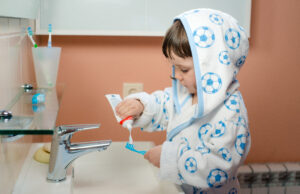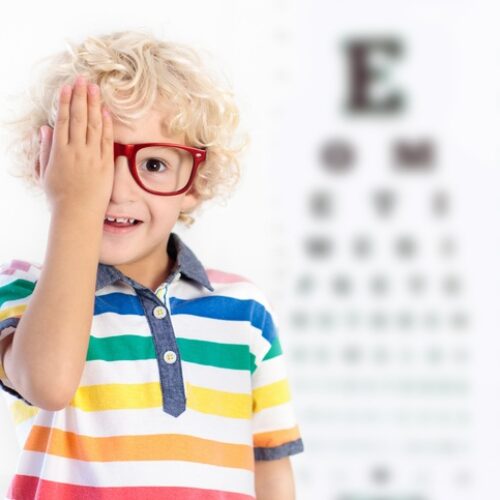Choosing children’s toothpaste

One of the most important steps you can take to protect your child’s teeth is to choose the right toothpaste – one that is specially formulated for children.
With so many toothpaste options available on our supermarket shelves, it can be overwhelming to know what the difference is and which is the best one for your little ones. In this article, we provide some tips for choosing the right children’s toothpaste.
Why can’t children use adult toothpaste?
Children should not use adult toothpaste primarily because adult toothpaste often contains higher levels of fluoride, which can be harmful to little ones if they ingest it in large quantities.
What is fluoride?
Fluoride is an important ingredient in toothpaste because it helps prevent tooth decay and strengthens tooth enamel. However, young children, especially those under the age of six, are more prone to swallowing toothpaste while brushing their teeth. Gulping excessive amounts of fluoride toothpaste can lead to a condition called fluorosis, which causes white spots or streaks to appear on the teeth. In severe cases, it can cause brown discoloration and even weaken the enamel.
Children’s toothpaste
Children’s toothpaste, on the other hand, typically contains lower levels of fluoride or is fluoride-free, making it safer for children who are still learning to brush their teeth without swallowing the toothpaste. Additionally, children’s toothpaste often comes in flavours that are more appealing to kids, which can encourage them to brush regularly and develop good oral hygiene habits from a young age. These toothpastes may also be formulated with ingredients that are more gentle on a child’s developing teeth and gums.
Tips for choosing children’s toothpaste
With all that said, what should you consider when buying toothpaste for your little ones?
Look for fluoride
Fluoride is a mineral that helps strengthen tooth enamel and prevent tooth decay. Look for a toothpaste that contains fluoride, but be careful not to use too much. Children under six should use a pea-sized amount of toothpaste, and parents should always supervise brushing to make sure children don’t ingest the toothpaste.
Choose a nice flavour
Children are more likely to brush regularly if they enjoy the taste of their toothpaste. Many children’s toothpastes come in fruity or bubblegum flavours, which can make brushing more fun. With the right toothpaste, your child can truly enjoy learning to look after their dental health and take pride in it – both now and as a habit for the future.
Avoid harsh ingredients and check safety warnings
Some toothpastes contain harsh ingredients like sodium lauryl sulfate (SLS), which can cause mouth irritation. Look for a toothpaste that is gentle on your child’s teeth and gums. Make sure the toothpaste you choose is safe for children. Check the label for any safety warnings or age restrictions.
Consider your child’s specific needs
If your child has specific dental needs, such as sensitive teeth or braces, look for a toothpaste that is designed to address those issues. This is an easy way to make sure your little one avoids dental trouble later on.
Don’t be swayed by gimmicks
Some toothpastes are marketed with fancy packaging or promises of extreme whitening power. Don’t be swayed by gimmicks – focus on choosing a toothpaste that is safe and effective for your child.
Ingredients to avoid
When it comes to choosing toothpaste for kids, there are a few things to avoid. It’s essential to pay attention to the ingredients in children’s toothpaste to be certain it promotes their dental health, without posing any risks. Here are some ingredients you’ll need to watch out for:
Triclosan
Triclosan, an antibacterial agent commonly found in personal care products, has raised concerns due to its potential to disrupt hormones and contribute to antibiotic resistance. It’s best to steer clear of toothpaste containing triclosan, especially for young children whose bodies are still developing.
Microbeads
Microbeads, tiny plastic particles added to some toothpaste formulas for texture, can harm the environment. These beads often end up in waterways and pose a threat to aquatic life. Opting for toothpaste without microbeads helps reduce your environmental impact and teaches children about responsible consumer choices from an early age.
Artificial sweeteners
While toothpaste with artificial sweeteners might taste appealing to children, ingredients like aspartame can have adverse effects on health. Choosing toothpaste without artificial sweeteners ensures your child isn’t exposed to unnecessary additives that could potentially affect their wellbeing and give them a taste for this problematic chemical.
Whitening agents
While some toothpastes claim to whiten teeth, they may contain abrasive ingredients that can wear down tooth enamel, especially in developing teeth. While adults might seek whitening benefits, children’s toothpaste should prioritise enamel protection and cavity prevention over cosmetic enhancements, and so whitening toothpastes should generally be avoided for little gums and teeth!
By scrutinising toothpaste labels and avoiding these potentially harmful ingredients, you can make informed choices to safeguard your child’s oral health. Remember, the goal is to instil healthy dental habits early on and provide the best care you can for your child’s growing smile.
Image Credit: Shutterstock











Comments